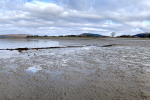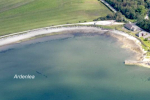The Thomas Harward was a wooden 3 masted barque rigged sailing vessel, built at Bath, Maine, USA and launched in 1859. She measured 186.0′ x 36.5′ x 23.6′ and her tonnage was 1236 gross tons, 1217 net tons. It is likely she was either built or owned by Thomas Harward, a shipbuilder and ship owner also based in Bath. There is little history of the vessel’s early years. She was purchased by John Brymner in 1873 and registered at Greenock on 27th June 1873 as the Ardenlea.
The Ardenlea was sold to a Gibraltar based company in 1881, Messers Carrara & Company, who planned to use the vessel as a coal hulk in the port of Gibraltar. On Friday 18th November 1881 she loaded 200 tons of coal ballast at Greenock and left the Tail of the Bank under tow of the Clyde Shipping Company’s paddle tug the Flying Huntsman. The tug was to tow her to Cardiff where she would load a full cargo of coal, have her masts and rigging removed before being towed to Gibraltar. She had aboard around ten riggers who would dismantle the bulk of her rigging during the journey. The riggers and a reduced deck crew were under the command of her master, Joseph Gregory.
The tug and her charge only got as far as seven or eight miles south of Little Cumbrae before worsening weather conditions made them turn around and seek shelter in Rothesay Bay. The anchorage was already busy and the ‘boisterous weather’ continued into Monday 21st and increased to a full storm. Even in the protected anchorage the sea state was wild, spindrift was whipped off the tops of waves and the ships at anchor were lashed with heavy rain as they rolled and crashed in the swell. The Ardenlea was at the mercy of the weather. She had both her main anchors down with chain but at some stage overnight she started to drag both anchors. Drifting through the anchorage she collided with David MacBrayne’s steamer the PS Islay carrying away her main mast and crushing one of her lifeboats. Fortunately she drifted north without further mishap but, by now totally out of control, she was heading for the shore at Ardyne Point.
It was not long before she began to bottom out on the sandy beach of Archenwilline Bay just to the west of Toward Castle. Here she was driven high up on the beach providing some safety for her crew who sheltered on her deck until the tide receded and thankfully all got ashore safely. In the mayhem both her fore and mizzen masts came down. For a while the main survived but, eventually, this too crashed into the sea due to the constant pounding of the wreck by the sea.
The storm abated on the afternoon of Tuesday 22nd November but the damage was done. The Ardenlea was awash at all states of the tide. There was some initial salvage of effects, rigging and anything loose of value taken into store. These materials and the wreck itself were advertised for sale by auction in January 1882 and were finally sold on 20th January to a local cooper, a Mr Graham for the sum of £245. The effects even included the anchors and chain that had been lost in Rothesay Bay on the night of the storm. These were recovered in early January by James Gush, a Greenock based salvage diver.
The remains of the Ardenlea can still be found in the bay west of Toward Yacht Club in position 55° 52.052’N, 05° 01.432’W. The remains consist mainly of a section of heavy wooden keel although rumour has suggested some sections of hull planking. As can be seen from the photographs, the remains can be exposed at LW spring tides. It likely that the sand covering the remains will vary in depth with prevailing weather and tidal conditions.


































